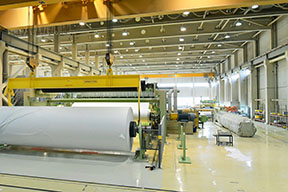Paper Products

This includes printing and writing paper, coated paper, tissue papers, etc.
Purchasing information:
- Avoid brightness standards or other specifications that would favor a virgin paper product but are not key to the product’s performance.
- Make sure your organization establishes procedures to minimize the use of paper. For example, encourage duplex copying, digital document review, electronic signatures, etc.
- Prior to choosing which recycled content copier paper to award a contract to, ask the departments or business sections that are high-volume users to test the paper and ensure that it meets their standards.
- For publications, let graphic designers and printers know of your interest in recycled content paper and work with them to find the best fit.
- Recycled content tissue paper should still be required to meet tensile strength, stretch and absorbency standards, or other standards that are important attributes to the application. (See Green Seal Standards for Sanitary Paper - https://greenseal.org/storage/standards/May2020/GS-1-6.2-Standard-2019.pdf )
Key specifications:
- The product shall meet or exceed the federal CPG guidelines for post-consumer recycled content.
- For imaging equipment (purchase and lease) contracts, require that the equipment be able to run 100% recycled content paper, even if your specifications for recycled content in paper allow for lower percentages.
- For extra environmental considerations, consider including “The product shall be certified by Green Seal and/or UL Ecologo.”
Resources for additional information:
- EPA Comprehensive Procurement Guidelines for Paper Products - https://www.epa.gov/smm/comprehensive-procurement-guidelines-paper-and-paper-products
- EPA’s 2007 Buy Recycled Series: Paper Products - https://www.epa.gov/sites/production/files/2016-02/documents/paper.pdf
- Conservatree - http://www.conservatree.org/paper/PaperTypes/RecyPpr.shtml
- Green Seal - https://www.greenseal.org/
- UL Ecologo - https://www.ul.com/resources/ecologo-certification-program